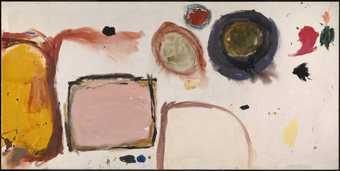During the twentieth century, the desire to 'purify' art – to eliminate representation and instead to address those characteristics which define the work of art as a thing in itself – became a preoccupation for many artists. This display focuses on the 1960s, an important decade in British art when this ethos received its most fertile expression. The radical developments in abstract painting and sculpture that took place during this period challenged convention, overturning assumptions about the subject matter, appearance and status of art.
The source of these developments was the exhibition Situation, which took place at the RBA (Royal Society of British Artists) Galleries, London in September 1960. The exhibition comprised paintings by twenty artists connected in ways that were not immediately obvious. It included, for example, older figures such as William Turnbull, then teaching at Central School of Art.
By 1959 Turnbull had already begun to make large paintings in which all reference to the outside world had been eliminated, replaced by fields of intense, saturated colour. This approach contrasted with that of Gillian Ayres; her work, though also nonrepresentational, emphasised gestural mark-making, differentiated colour and the relation of organic shapes.
A number of younger artists were also included, among them John Hoyland whose abstract paintings used simple geometric elements to create a sense of expanding space. Between these extremes, a wide constituency of other styles and methods was apparent.
Despite the absence of any definite group identity, the Situation artists were nevertheless linked in certain respects. In 1959, the Tate Gallery's exhibition of Abstract Expressionism, The New American Painting, had been a confirming experience. The powerful influence exercised by the American painters is manifest in two common threads, which the organisers expressed as conditions for inclusion in the Situation exhibition. The first condition was that the work shown should be abstract.This rejected the literal representation of recognisable subjects and also abstraction from nature – a stipulation that pointedly excluded the earlier generation of St Ives painters whose work was rooted in observation. Situation emphasised the importance of working with purely pictorial elements without explicit reference to outside phenomena.
The second criterion for inclusion was that the paintings should be large in scale: no work was to be less than thirty square feet. This had far-reaching implications. Traditional easel painting creates an illusory, recessive space into which the viewer looks, as if standing outside the world contained within the picture.
The insistence on large scale draws the spectator and the work of art into a new, completely different relationship. Standing close to a mural-size painting means that it cannot be apprehended within a single viewpoint. Instead, the viewer is enveloped. Scanning the image requires physical movement – looking up and down or from side to side – as the gaze explores an expanse. A total image is built from a sequence of connected impressions. As a result, the viewer does not look into the painting. Rather, the painting confronts the viewer as an object with its own independent characteristics, or even as an environment whose surface features are experienced in a non-representational, literal way.
Experiencing the work of art as a real thing in itself is a primary characteristic of 'Situation' painting. It also defines the work of the other painters and sculptors included in this display, who were not directly connected with Situation but who shared certain ideas. Bridget Riley, for example, tended to work on a relatively small scale during the early 1960s, and the formal characteristics of her paintings are a means of generating various visual sensations and perceptual experiences. Even so, such experiences are the real, tangible content of her art. Direct engagement with the physical presence of the work of art is the central characteristic of the abstract sculpture made at this time.
From 1960, Anthony Caro pioneered the creation of sculpture that is insistently abstract and composed of industrial materials. They are composed expressively; but being placed directly on the floor – in the same space as the viewer – such sculptures are as actual and immediate as any familiar object.
Formal Situations surveys an extraordinary moment in British art. The artists in this display responded to the ambition and innovation of Abstract Expressionism, but they also extended that legacy in unexpected ways. The Abstract Expressionists had made art out of the flux of their own subjective, inner experiences. The 1960s saw a generation of British artists embracing the expressive potential of abstraction – but with a certain detachment and growing objectivity. By focusing on the abstract properties of painting and sculpturespace, surface, scale, formal organisation and process – they gave the elements that comprise art a new, self-contained role and significance. In so doing they reaffirmed the language of abstraction, investing it with a startling assurance, clarity and vitality.


